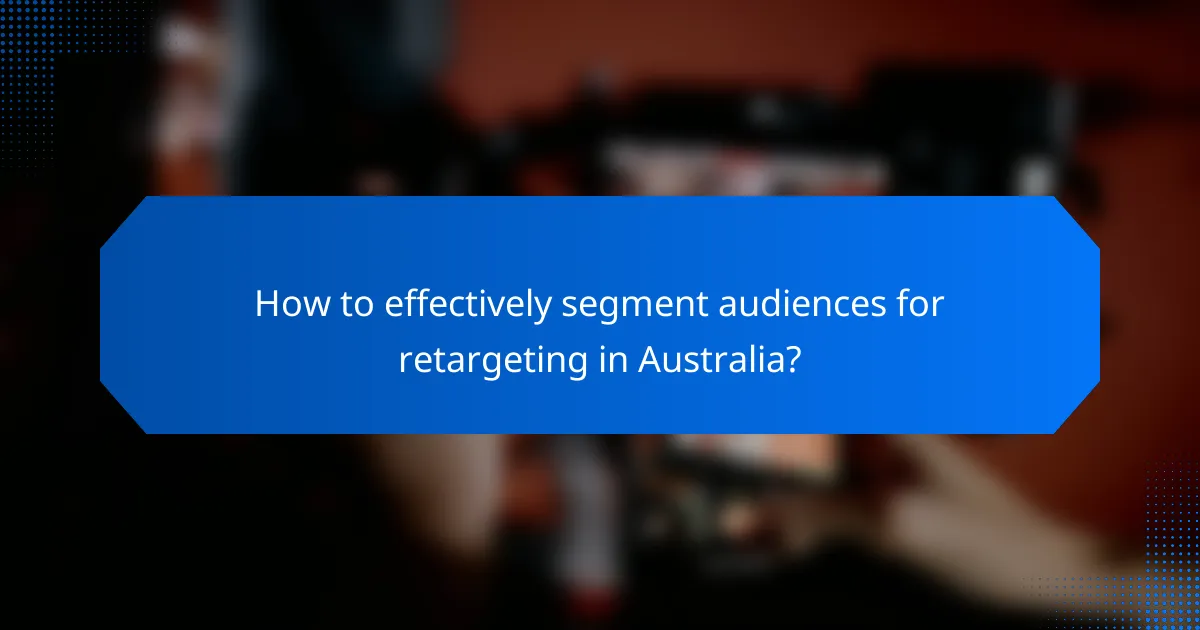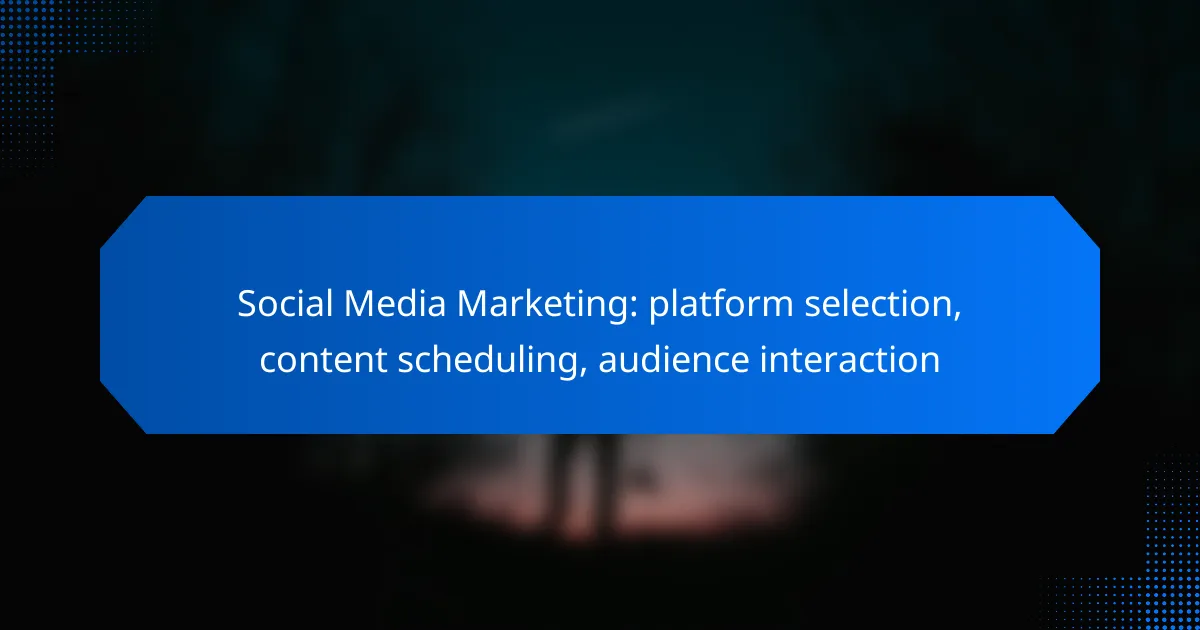Retargeting campaigns are a powerful tool for marketers, allowing them to reconnect with potential customers through strategic audience segmentation. By tailoring ads to specific groups and utilizing optimal placements across various platforms, businesses can significantly enhance engagement and conversion rates. Additionally, effective conversion tracking is crucial for evaluating the success of these campaigns, enabling marketers to refine their strategies and maximize return on investment.

How to effectively segment audiences for retargeting in Australia?
To effectively segment audiences for retargeting in Australia, focus on identifying key characteristics that define your target groups. This approach enhances ad relevance and increases the likelihood of conversions by tailoring messages to specific audience needs.
Demographic segmentation
Demographic segmentation involves categorizing audiences based on characteristics such as age, gender, income, and education level. For instance, targeting ads for luxury products to high-income individuals can yield better results than a broad approach.
In Australia, understanding the demographic profile of your audience can help refine your messaging. For example, younger audiences may respond better to digital ads on social media platforms, while older demographics might prefer email campaigns.
Behavioral segmentation
Behavioral segmentation focuses on users’ interactions with your brand, including purchase history, website visits, and engagement levels. By analyzing these behaviors, you can create tailored ads that resonate with users based on their previous actions.
For example, if a user frequently visits your product page but hasn’t made a purchase, a targeted ad offering a discount could encourage conversion. Tracking user behavior helps in crafting personalized experiences that drive engagement.
Contextual segmentation
Contextual segmentation targets audiences based on the context in which they encounter your ads, such as the content they are consuming or the time of day. This method ensures that your ads are relevant to the moment, increasing the chances of engagement.
For instance, displaying ads for outdoor gear during summer months or in articles about travel can effectively capture the interest of potential buyers. Timing and context are crucial for maximizing ad effectiveness.
Psychographic segmentation
Psychographic segmentation dives into the attitudes, interests, and lifestyles of your audience. Understanding these factors allows you to create ads that align with the values and motivations of your target groups.
For example, if your audience values sustainability, highlighting eco-friendly aspects of your products can resonate more deeply. This approach fosters a connection between the brand and the consumer, enhancing loyalty and conversion rates.
Geographic segmentation
Geographic segmentation divides audiences based on their location, which can significantly influence purchasing behavior. In Australia, regional differences can impact preferences, making it essential to tailor ads accordingly.
For instance, promoting winter clothing in southern regions during colder months while focusing on summer apparel in northern areas can optimize your ad spend. Understanding local trends and preferences is key to effective retargeting campaigns.

What are the best ad placements for retargeting campaigns?
The best ad placements for retargeting campaigns include social media platforms, relevant websites, streaming services, and mobile applications. Each placement has unique advantages that can enhance visibility and engagement with your target audience.
Display ads on social media platforms
Social media platforms like Facebook, Instagram, and Twitter are effective for display ads in retargeting campaigns. These platforms allow advertisers to reach users who have previously interacted with their brand, leveraging user data to tailor ads that resonate.
Consider using eye-catching visuals and concise messaging to capture attention. Ads can be optimized for various formats, such as stories or feed posts, depending on where your audience is most active.
Banner ads on relevant websites
Banner ads on websites that align with your brand can effectively retarget users. By placing ads on sites that your audience frequents, you increase the chances of re-engaging potential customers.
Choose websites that complement your product or service. For example, if you sell outdoor gear, consider placing ads on travel or adventure blogs. Monitor performance metrics to adjust placements as needed.
Video ads on streaming services
Video ads on streaming services like YouTube can be powerful for retargeting campaigns. These ads can reach users who have shown interest in your products through previous interactions, making them more likely to convert.
Keep videos short and engaging, ideally under 30 seconds, to maintain viewer attention. Utilize call-to-action buttons to encourage immediate responses, such as visiting your website or making a purchase.
In-app advertisements
In-app advertisements are another effective placement for retargeting campaigns, especially for mobile users. Ads can be shown in apps that your target audience frequently uses, ensuring that your brand remains top-of-mind.
Focus on user experience by selecting apps that align with your audience’s interests. Use formats like interstitials or native ads to blend seamlessly with the app’s content, enhancing engagement without being intrusive.

How to track conversions in retargeting campaigns?
Tracking conversions in retargeting campaigns is essential for measuring effectiveness and optimizing ad spend. It involves monitoring user actions after they interact with your ads, allowing you to assess which strategies yield the best results.
Using Google Analytics
Google Analytics provides robust tools for tracking conversions in retargeting campaigns. By setting up goals, you can monitor specific user actions, such as purchases or sign-ups, and analyze how retargeted users behave compared to new visitors.
To implement this, navigate to the ‘Admin’ section, select ‘Goals’, and define the desired actions. Ensure that your Google Analytics account is properly linked to your ad platforms for accurate data collection.
Implementing Facebook Pixel
Facebook Pixel is a powerful tool for tracking conversions from your retargeting ads on Facebook. By placing the Pixel code on your website, you can track user interactions and optimize your ad campaigns based on real-time data.
To set up the Pixel, create it in your Facebook Ads Manager, then add the code to your website’s header. Monitor the Pixel’s performance through the Events Manager to see how well your retargeting efforts convert.
Utilizing conversion tracking tools
Various conversion tracking tools can enhance your retargeting campaigns by providing detailed insights. Tools like AdRoll or Criteo offer built-in tracking features that help you measure the effectiveness of your ads across multiple platforms.
When selecting a tool, consider its integration capabilities with your existing systems and the specific metrics it tracks. This will ensure you get the most relevant data for optimizing your campaigns.
Setting up UTM parameters
UTM parameters are tags you can add to your URLs to track the performance of your retargeting campaigns in Google Analytics. By using UTM parameters, you can identify which ads are driving traffic and conversions.
To set up UTM parameters, use the Google Campaign URL Builder. Include parameters like source, medium, and campaign name to categorize your traffic effectively. This will allow you to analyze the performance of each retargeting ad in detail.

What criteria should be considered for retargeting campaign success?
Successful retargeting campaigns hinge on several key criteria, including audience segmentation, ad placement, and conversion tracking. By focusing on these elements, marketers can optimize their strategies to effectively reach and convert previous website visitors.
Click-through rates
Click-through rates (CTR) measure the percentage of users who click on an ad after viewing it. A higher CTR indicates that the ad is resonating with the audience, which is crucial for retargeting success. Aim for CTRs in the low to mid-single digits as a benchmark for effective campaigns.
To improve CTR, consider tailoring ad creatives to specific audience segments based on their previous interactions with your site. For instance, showcasing products that users viewed but did not purchase can entice them back to complete the transaction.
Return on ad spend
Return on ad spend (ROAS) evaluates the revenue generated for every dollar spent on advertising. A positive ROAS indicates that the retargeting campaign is financially viable. Generally, a ROAS of 400% (or 4:1) is considered a good target in many industries.
To enhance ROAS, focus on optimizing ad placements and targeting the right audience segments. Regularly analyze performance data to identify which ads yield the highest returns and adjust your strategy accordingly. Avoid overspending on underperforming ads to maintain a healthy return on investment.

